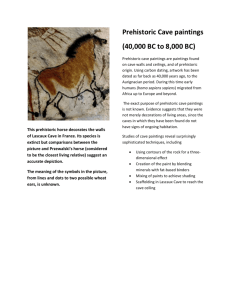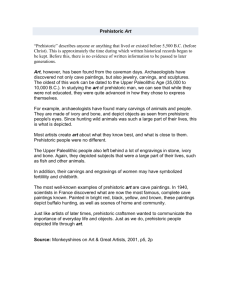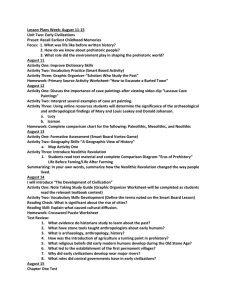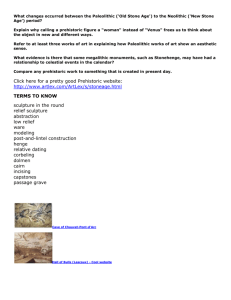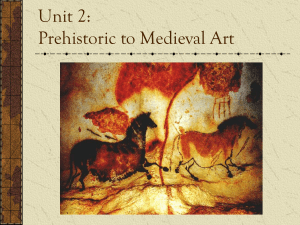Prehistoric paintings in the Altamira Cave, Santillana (Spain)
advertisement
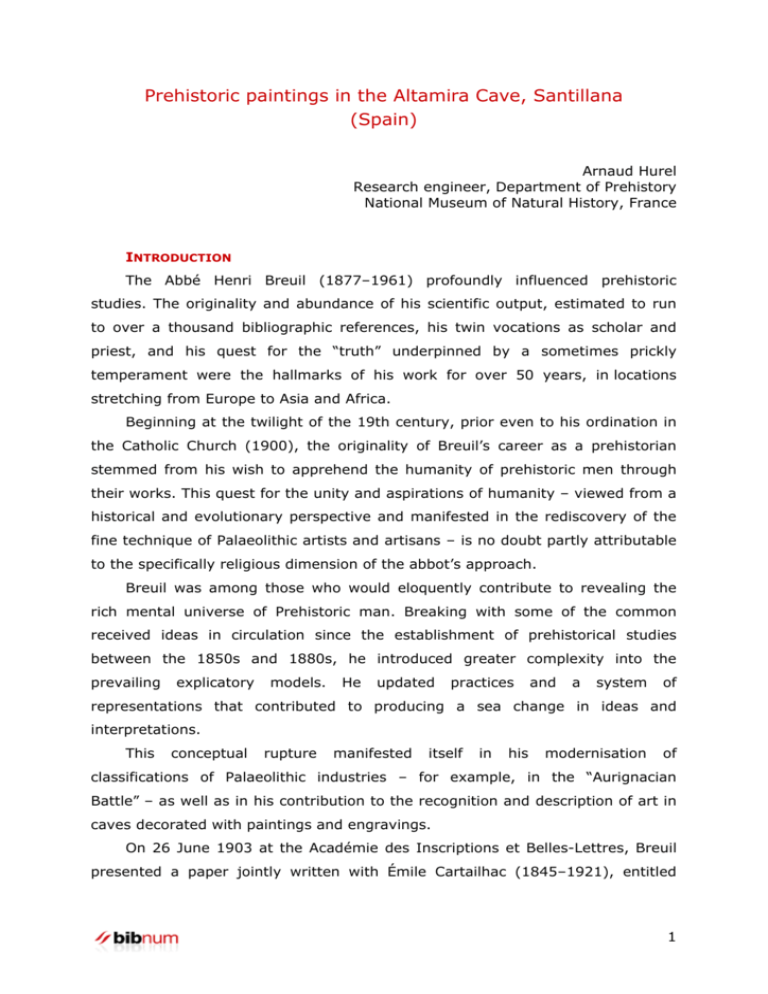
Prehistoric paintings in the Altamira Cave, Santillana (Spain) Arnaud Hurel Research engineer, Department of Prehistory National Museum of Natural History, France INTRODUCTION The Abbé Henri Breuil (1877–1961) profoundly influenced prehistoric studies. The originality and abundance of his scientific output, estimated to run to over a thousand bibliographic references, his twin vocations as scholar and priest, and his quest for the “truth” underpinned by a sometimes prickly temperament were the hallmarks of his work for over 50 years, in locations stretching from Europe to Asia and Africa. Beginning at the twilight of the 19th century, prior even to his ordination in the Catholic Church (1900), the originality of Breuil’s career as a prehistorian stemmed from his wish to apprehend the humanity of prehistoric men through their works. This quest for the unity and aspirations of humanity – viewed from a historical and evolutionary perspective and manifested in the rediscovery of the fine technique of Palaeolithic artists and artisans – is no doubt partly attributable to the specifically religious dimension of the abbot’s approach. Breuil was among those who would eloquently contribute to revealing the rich mental universe of Prehistoric man. Breaking with some of the common received ideas in circulation since the establishment of prehistorical studies between the 1850s and 1880s, he introduced greater complexity into the prevailing explicatory models. He updated practices and a system of representations that contributed to producing a sea change in ideas and interpretations. This conceptual rupture manifested itself in his modernisation of classifications of Palaeolithic industries – for example, in the “Aurignacian Battle” – as well as in his contribution to the recognition and description of art in caves decorated with paintings and engravings. On 26 June 1903 at the Académie des Inscriptions et Belles-Lettres, Breuil presented a paper jointly written with Émile Cartailhac (1845–1921), entitled 1 1 “The prehistoric paintings of the Cave of Altamira in Santillana (Spain)”. It was a decisive phase in the endeavour, both for Breuil and for science. Figure 1: Émile Cartailhac (seated) and Henri Breuil (third from the right) at the entrance of the Gargas painted cave (Hautes-Pyrénées) in July 1907 (photograph Fondation Institut de paléontologie humaine). PREHISTORIC ART: UNIQUELY DECORATIVE? At the dawn of the 20th century, prehistory as a science had gained credibility and legitimacy. Since the international recognition (1859) of the work of Jacques Boucher de Perthes (1788–1868) in the alluvial terraces of the Somme, the ancientness of humankind was an acknowledged fact. Older discoveries, which already indicated the possible coexistence of human beings with animals of our regions extinct or lost since time immemorial, could be reexamined with fresh eyes and scientifically validated retrospectively. A veritable research movement emerged, eliciting the curiosity of archaeologists alike. Many discoveries were made and naturalists and a community of researchers developed. An image of prehistoric peoples, much influenced by a singular reading of Darwinian theory of evolution, gradually emerged. It was premised on a revised 1. Édouard Cartailhac and Henri Breuil, “Les peintures préhistoriques de la grotte d’Altamira à Santillane (Espagne)”, CRAI, 1903, vol. 46, pp. 256–265 [BibNum text]. 2 understanding of their material productions, discovered alongside fossilised fauna. From the 1860s onwards the first prehistorians emphasised the quality of the engraved or sculpted objects they had discovered. A naturalist art revealed itself their eyes and some of the items exhumed during excavations in the Périgord, led by Édouard Lartet (1801–1871) and Henry Christy (1818–1865), were elevated to the status of masterpieces. The Age of the Reindeer, the Magdalenian of the High Palaeolithic, became a kind of golden age of prehistory. For Édouard Piette (1827–1906), prehistoric man of this age was an ingenious man, given to the arts of drawing and sculpture, the inventor of the harpoon, hook, spoon, needle and a multitude of instruments no longer in use; armed with the brushstroke and the dagger, he was in his own time one of the pioneers of civilisation; he marked with his footprint a step in humanity’s path to progress. He was not a savage imprisoned in the narrow confines of his fathers’ ideas; he had been a man of progress and could be still. […] Exercise and the outdoors life infused in these savages, whom we deem wretched, a morality, strength and calm that 2 working populations or office clerks will never know. Gabriel de Mortillet (1821–1898), the other master of European prehistory, considered this art as the manifestation of an intelligence about beauty and truth, the copy of a reality proffered by the spectacle of nature: We are here in the presence of the childhood of art, but of an art very true and real. Though it is the childhood of art, it is in no way the art of a child. 3 Art, in its decorative dimension, was immediately integrated into the repertoire of aptitudes ascribed to prehistoric peoples. When, in 1880, the Spaniard Marcelino Sainz de Sautuola (1831–1888) presented his discovery in the Altamira Cave, near to Santander, of “rather large red and black [paintings] of various animals”, which he estimated to be contemporaneous with the rich 4 archaeological deposit of an “industry of the stone age”, he was, one would think, justified in expecting an attentive and favourable response. This was not to be the case. 2. Édouard Piette, “Sur la grotte de Gourdan, sur la lacune que plusieurs auteurs placent entre l’âge du renne et celui de la pierre polie, et sur l’art paléolithique dans ses rapports avec l’art gaulois”, Bulletin de la Société d’anthropologie de Paris, 1873, IIe Série, vol. 8, pp. 384–425. 3. Gabriel de Mortillet, “L’art dans les temps géologiques”, Revue scientifique, 1877, 2e série, vol. 12, p. 888– 892. 4. Marcelino Sainz de Sautuola, Breves apuntes sobre algunos objetos prehistoricos de la provincia de Santander, Madrid, Librairie Murillo, 1880, 28 p. 3 Figures 2 and 3: Tracing of the polychrome ceiling of the Altamira Cave published by Sanz de Sautuola in 1880 (in Cartailhac, “La grotte d'Altamira. ‘Mea culpa’ d'un sceptique”, L’Anthropologie, 1902) (image Gallica); (below) Magdalenian bison from Altamira ((WikiCommons, Museo de Altamira and D. Rodríguez) At the International Congress of Prehistoric Archaeology and Anthropology at Lisbon, in 1880, his Madrilenian colleague Juan Vilanova y Piera (1821–1893) attempted to rally the scientific community around this discovery. But the 4 prominent figures within European prehistory were sceptical, even hostile, to the idea of acknowledging the antiquity of the Altamira paintings: These strange paintings were thus unique in their genre; their age was not definitive. The distrust was particularly pronounced in France. Cartailhac, among others, suspected fakery and Mortillet remained attached to a narrow vision of the history of human progress, one which was incompatible with such elaborate artworks emanating from such distant times. In the absence of any debate, a study mission was initiated. Édouard Harlé (1850–1922) travelled to the site in 1881, publishing an account of his visit in the journal Matériaux pour l’histoire primitive et naturelle de l’homme, of which Cartailhac was the editor. His report concluded that the drawings were not contemporaneous with the archaeological deposit and that they “dated from some time ago, but not from the period of the remains – far 5 from it”. In 1903, recalling this assessment of the monument, Breuil deplored that this rapid examination was not favourable to dating the paintings – which are often very perfected, fresh in appearance, and which only artificial light could adequately illuminate – to the stone age. The study of this cave therefore remained superficial and incomplete. @@@@@@@ Ostracised, the Altamira Cave and its paintings languished in oblivion for several decades. However, other similar discoveries were made, including in France: Le Figuier (1894), Pair-non-Pair (1895), La Mouthe (1895) and Marsoulas (1897). But it was the discovery in September 1901 of the paintings and engravings of the caves of Les Combarelles and Font-de-Gaume, in Eyziesde-Tayac (Dordogne), by Breuil, Louis Capitan (1854–1929) and Denis Peyrony (1869–1954) which would demonstrate that the decoration of caves with line engravings and red and black paintings, at a rather early stage of the Quaternary and the stone age, made it important to seek out other examples and carefully study all aspects. And yet, wasn’t the first of these examples to be found in Spain, at Altamira? 5. Édouard Harlé, “La grotte d’Altamira, près de Santander (Espagne)”, Matériaux pour l’histoire primitive et naturelle de l’homme, 1881, vol. 12, pp. 275–283. 5 REDISCOVERING ALTAMIRA This proliferation of painted caves meant that each new discovery consolidated each of the earlier ones. More generally, this succession of new sites of paintings and engravings lent credence to the idea that parietal art had been practised in very ancient times – during the Palaeolithic – and frequently. From the point of view of the age one should ascribe to them, they consolidate one another. The rediscovery of Altamira thus seemed self-evident, both as a contribution to the process of acknowledging prehistoric cave paintings but also as a symbolic gesture of redemption preceding Cartailhac’s avowal of contrition – his “mea 6 culpa of a sceptic” – which would mark his personal and official conversion to Palaeolithic parietal art. At the end of the summer of 1902 Breuil and Cartailhac, endowed with a small subsidy from the Académie des Inscriptions et Belles-Lettres, left for Spain to travel to Altamira. They stayed there a month, spending all their time studying the cave and tracing its paintings and engravings. Breuil had developed an empirical technique for this work since his study of Les Combarelles and Font-de-Gaume. He chose to make an initial sketch directly on the cave wall – a classic method used in numismatics and epigraphy – even if this entailed using water to brighten the engravings and paintings, and then reduced this drawing by a fifth using a camera lucida. The result was then copied onto thick paper. For the final stage – adding colours – he returned to the cave and worked directly in front of the sketched figure. At Altamira, this work would prove exhausting. The days were punctuated by the abbot’s daily mass, and then by several hours of wearying work lying prostrate on sacks of hay on the floor of the cave, constantly adjusting his position to draw the compositions in their entirety. While Breuil drew, Cartailhac measured the figures and instructed workmen bearing candles on where to stand – the abbot’s cassock was soon stained with wax – so that the light revealed the details of the paintings and engravings. 6. Émile Cartailhac, “Les cavernes ornées de dessins. La grotte d’Altamira, Espagne. ‘Mea culpa’ d’un sceptique”, L’Anthropologie, 1902, vol. 13, pp. 348–354. 6 Figure 4: A cave bison at Altamira sketched by Breuil (in Cartailhac & Breuil, La caverne d’Altamira à Santillane près Santander (Espagne), Monaco, 1906) THE “SISTINE CHAPEL” OF QUATERNARY ART IS FINALLY REVEALED On entering the cave, Breuil and Cartailhac, like Sautuola and Harlé, discovered that it had been used by prehistoric peoples over a long period of time. The extent of the archaeological deposit pointed to a longstanding human presence on the site: Traces of prehistoric inhabitation are considerable and localised at the entrance. Mankind must have frequented this place for a long time and at length. A very large deposit measuring over a metre in depth covers the floor and is composed of carbonaceous ash mixed with edible shells from the neighbouring sea and broken bones. Alongside these culinary scraps one finds the abundant remains of worked objects made out of stone or bone. The two men were dazzled by the number and diversity of paintings they discovered as they moved the flickering candlelight. They noted the resemblance of these representations to those they had studied in France and endeavoured first and foremost to study series of simple or composed geometric figures: The black signs are distributed irregularly on the right and left walls of the second and last parts of the tunnel. They are within arm’s reach but are not always in the places one first sees, which probably rules out the idea that they are waymarks to aid movement. In general they are made up of several strokes, which makes them somewhat analogous with written 7 characters. But however simple they may be – confined to a few strokes or more complicated – their variety knows no bounds; one does not see two of the same. These strokes are undoubtedly ancient, for sometimes engravings representing animals are superimposed on them: The ancientness of the black signs is demonstrated by the fact that they are intersected by engravings, at least by two of the best and most characterised of the figures produced by point drawing, which constitute the second series of human works in the cave. These engravings reminded Breuil and Cartailhac of “the style and the craftsmanship of the bone drawings of the Age of the Reindeer” as well as of the “engravings already noted in our French caves”. Among the engravings, the two researchers distinguished potentially human figures on the ceiling of the first room: The man being seen in profile, his arms raised in the classic posture of a worshipper, his hands at the highest point of the figure. In some of the figures, the characters are faceless or wearing a mask. Ethnographic comparatism, then very much in vogue among prehistorians wishing to make sense of prehistoric artefacts, led Breuil and Cartailhac to imagine this as a disguise, such as that in use among American Indians. The abundant red signs seemed to be organised in groups and some evoked the “deformed image of a pirogue”, the kayak of the Eskimos. All these signs presented the image of a coherent but highly enigmatic corpus. Yet it was the surprising spectacle of grand naturalist colour paintings covering “the primitive engravings and paintings” on the ceiling that produced the greatest emotional and aesthetic shock. These were not a few abstract signs but a veritable bestiary, an astounding pictorial work looming out of the Palaeolithic. The representations discovered by Breuil and Cartailhac were a far cry from the pallid sketch – a few strokes depicting the frail silhouette of a deer – that Harlé had published in 1881 in a plate appended to his report. The animals, depicted with great realism, seem startled and on the verge of leaping: But further on, covering the primitive engravings and paintings, one finds a far more astonishing decoration, of far greater value. Twenty-five animals, namely twenty-one bison, two wild boar, a horse and a doe, measuring 1 m 25 to 2 m 20 in length, are more or less juxtaposed. They face in different directions and positioned in attenuated profile, which in general displays their four hooves and the bovines’ two horns. They are 8 standing, apart from five bison whose limbs are raised towards their bodies and give the impression of seated or ruminating oxen, or better still leaping with limbs curled inward and horns tilted forward. Figure 5: Altamira Cave, Harlé report (1881). A very schematic sketch of a bison can be seen in the bottom right. Extract from Émile Harlé, “La grotte d’Altamira, près de Santander (Espagne)”, Matériaux pour l’histoire primitive et naturelle de l’homme, 1881, vol. 12, p. 275–283. CONCLUSION For the young Breuil, the stay in Altamira was a crucial experience, both on a personal level – in his daily exchanges with Cartailhac, whose personal philosophy was, all in all, far removed from that of the Roman Catholic Church – and scientifically speaking, through the discovery of a site that literally gripped him and became his life’s work. He returned from Spain laden with sketches and, above all, with scientific certainties: 9 To summarise, the engravings and paintings of the Altamira Cave belong to age identified exactly, that is the beginning of the fine Age of the Reindeer proper. These are Palaeolithic works of art. The cave art of Périgord is not therefore exceptional; similar art exists on both sides of the Pyrenees, where it developed in the Palaeolithic and played a major role in Prehistoric societies. The similitude of themes and styles allows us to evoke the hypothesis of artistic schools. The parietal stratigraphy undertaken by Breuil and revealing superimposed representations unveiled a rupestrian art with its own history and chronology. It also invites us to envisage the transmission of know-how from generation to generation. This art was the vector of a veritable cultural tradition: The evidence observed at Altamira shows, more comprehensively than anywhere else, the importance attached to these images in the preoccupations and social life of the primitive peoples who produced them; they hint at the existence of same beliefs and superstitious practices in large parts of the West. They affirm the unity of the population. This note conserved at the Académie des Inscriptions indicates Cartailhac as the first signatory. In reality, Breuil, the pupil, would quickly surpass his master by forging an original body of thought and work promoting a new image of prehistoric peoples, whose rich and complex mental universe he revealed. On this journey, which would lead him to the Collège de France (1929), he received crucial support from Prince Albert I of Monaco (1848–1922) who, from 1904 onwards, financed the totality of Breuil’s work on cave art. (July 2013) (Translated by Helen Tomlinson, published September 2014) 10

